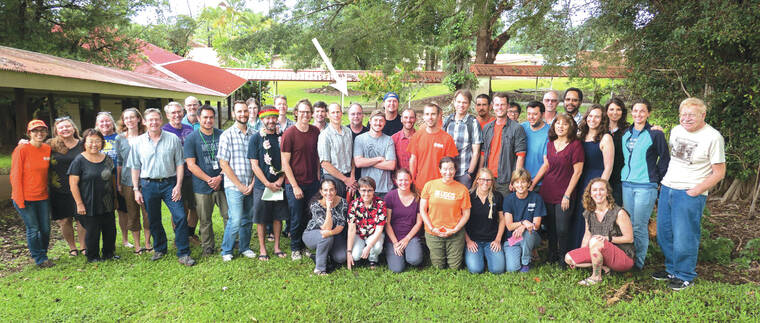Volcano Watch: In remembrance of Ed Brown, HVO ‘ohana


On May 15, 2024, our friend and colleague Ed Brown, associate director for infrastructure and facilities for the USGS Volcano Science Center (VSC), passed away unexpectedly due to natural causes while on a site visit to the USGS Hawaiian Volcano Observatory (HVO).
For more than 43 years, Ed was a valued and impactful member of the VSC/HVO team. His skills in geophysics, information technology, telecommunications, construction, management and field work kept the USGS and its five volcano observatories at the forefront of volcano science and public service.
ADVERTISING
Ed joined the USGS in the wake of the 1980 eruption of Mount Saint Helens. He spent long days in the field monitoring Cascade Range volcanoes, often in extreme conditions and in remote locations. His aptitude for information technology (IT) brought him out of the field and to the forefront of computer science as he pioneered the introduction of computing and networking resources into USGS volcano observatory operations.
Ed was a natural and gifted problem solver, and he worked closely with observatory staff to understand their challenges and needs. He helped improve volcano monitoring and data transmission capabilities by introducing new computer hardware, software, methods and services. From introducing state-of-the-art scientific instruments to preserving historic data by digitizing archived records, Ed always came up with resources and creative ways to get things done.
Not only did he help each observatory with specific needs, Ed helped bring all the USGS observatories together into an interconnected whole. This was critical to the development and implementation of the National Volcano Early Warning System (NVEWS). NVEWS is a national-scale plan to ensure that the most hazardous volcanoes are properly monitored so that scientists can improve the timeliness and accuracy of hazard forecasts and for citizens to take proper and timely action to reduce risk.
Ed was based at the Cascades Volcano Observatory (CVO) in Vancouver, Washington, but he spent a great deal of time in Hawaii at HVO. And he understood that two of the six active volcanoes in Hawaii — Kilauea and Mauna Loa — are among the highest threat volcanoes in the U.S. He worked hard to help the people of Hawaii by increasing the USGS’s ability to provide useful, reliable hazard information.
He experienced the power of Kilauea eruptions firsthand during the 2018 lower East Rift Zone eruption and summit collapse. During the 2018 crisis, Ed ensured that critical monitoring data were delivered to scientists and emergency managers one minute, solved complex and time sensitive computer issues the next minute, and packed boxes in the damaged HVO building in Hawaii Volcanoes National Park the next minute.
After helping rescue items from HVO’s building at Uekahuna, Ed immediately began locating and establishing temporary facilities for HVO. It was Ed who found the space in the Hilo Ironworks building where HVO is based now. And Ed was a major contributor to planning HVO’s future facilities that are now under construction on the University of Hawaii at Hilo campus and in Hawaii Volcanoes National Park.
When it came to designing HVO’s future facilities, Ed had plenty of experience to draw on. He helped design and build the current CVO building. He helped oversee the relocation of California Volcano Observatory and he managed Alaska Volcano Observatory facility upgrades as well.
Ed cheerfully did the things big and small that few others were keen to do or had the skills to do. Yet he avoided the spotlight. He enjoyed working behind the scenes. A humorous example of this occurred when the USGS presented Ed with a lifetime achievement award onstage at a major conference. Everyone was cheering and smiling at this recognition, except Ed himself! He preferred helping others instead of celebrating his own many accomplishments.
Over the years, Ed faced his many challenges with good humor and perseverance, and he always rose to the occasion. His accomplishments had, and will continue to have, a profound impact on our ability to execute USGS goals and mission on behalf of the American people. His sudden passing is a tremendous loss, but he leaves a profound legacy. He made the USGS, VSC, HVO — and the world — a better place. Mahalo nui loa, Ed Brown.
Volcano activity updates
Kilauea is not erupting. Its USGS Volcano Alert level is ADVISORY.
Following the June 3 eruption, magma has been repressurizing the storage system beneath Halema‘uma‘u and the south caldera region, activating earthquakes in the upper East Rift Zone and in the caldera south of Halema‘uma‘u. About 545 events occurred in this region over the past week, which is about double the number that occurred during the previous week. Inflationary ground deformation has also continued in the summit region. The most recent summit sulfur dioxide emission rate measured was approximately 50 t/d on June 10, 2024. Currently, there are no signs of an imminent eruption, but changes can occur quickly, as can the potential for eruption.
Mauna Loa is not erupting. Its USGS Volcano Alert Level is at NORMAL.
Three earthquakes were reported felt in the Hawaiian Islands during the past week: a M3.1 earthquake 20 km (12 mi) ESE of Naalehu at 37 km (22 mi) depth on June 26 at 5:48 a.m. HST, a M2.6 earthquake 6 km (3 mi) S of Volcano at 1 km (0 mi) depth on June 24 at 7:36 p.m. HST, and a M3.0 earthquake 6 km (3 mi) S of Volcano at 1 km (0 mi) depth on June 23 at 3:23 p.m. HST.
HVO continues to closely monitor Kilauea and Mauna Loa.
Please visit HVO’s website for past Volcano Watch articles, Kilauea and Mauna Loa updates, volcano photos, maps, recent earthquake information, and more. Email questions to askHVO@usgs.gov. Volcano Watch is a weekly article and activity update written by U.S. Geological Survey Hawaiian Volcano Observatory scientists and affiliates.






